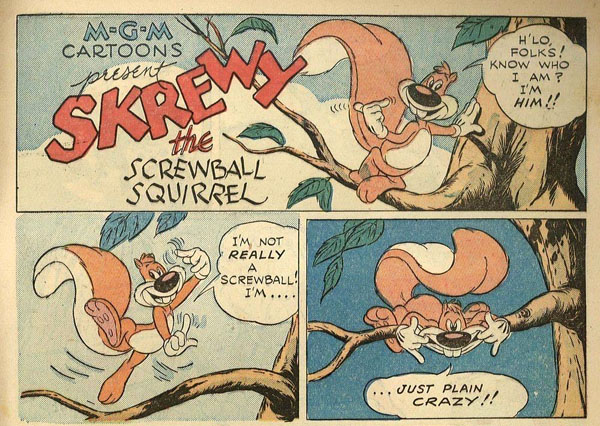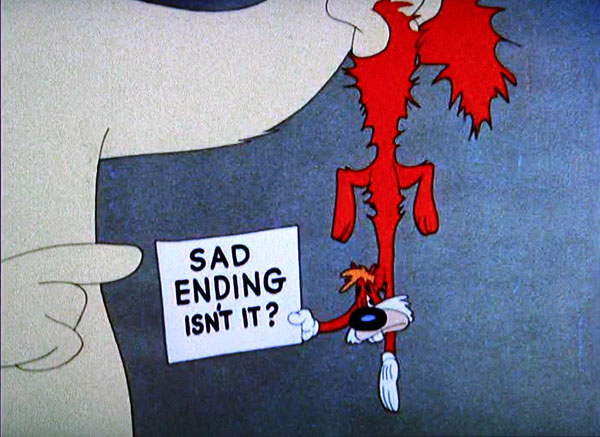



“On April 1, 1944, [Tex] Avery unleashed an April Fool’s joke on the world. In the short Screwball Squirrel, he introduced Screwy Squirrel, who was two degrees of separation on the insanity scale from Daffy Duck, another of Avery’s ‘discoveries’ when he was at Warners.” – John Canemaker, in his book Tex Avery: The Great American Director from the Golden Age of the Hollywood Cartoon.
 MGM’s Screwball Squirrel, celebrating its 80th anniversary this year, does indeed dial-up the “insanity” to 11 and stands as another brilliant notch in director Tex Avery’s legendary, over-the-top animation career.
MGM’s Screwball Squirrel, celebrating its 80th anniversary this year, does indeed dial-up the “insanity” to 11 and stands as another brilliant notch in director Tex Avery’s legendary, over-the-top animation career.
Screwball Squirrel announces itself in the opening moments of the short subject, taking a comedic swing at the milder Disney short subjects, as a cute, Disney-esque character named Sammy Squirrel skips across the screen, collecting nuts, and tossing them in a basket.
As he is about to pick up one of the nuts, Screwy Squirrel appears, asking, “Hey, what kind of cartoon is this going to be anyway?” “Well, you see, I play the lead in this picture,” Sammy answers timidly, with a smile on his face. “My name is Sammy Squirrel, and the story is all about me and my cute little furry friends in the forest.” Screwy rolls his eyes, exclaiming, “Oh brother! Not that!”
As Sammy continues to drone on, Screwy walks his fellow squirrel behind a tree and proceeds to pummel the cute little critter (we only see stars and hear the clamor, making it funnier). Screwy then tells the audience, “You wouldn’t like that story, anyway.”
 The story that does play out in Screwball Squirrel is one in which the titular character tortures a poor dog named Meathead. What follows is almost a “best of” Avery’s classic cartoon comedy gags.
The story that does play out in Screwball Squirrel is one in which the titular character tortures a poor dog named Meathead. What follows is almost a “best of” Avery’s classic cartoon comedy gags.
When Screwy smacks Meathead in the face with fly paper, the dog’s face peels off on the paper, leaving a white, blank slate where the dog’s features once were. When Screwy looks at the paper, multiples of the squirrel’s head pop out of his body in surprise.
Screwball Squirrel also plays with the fact that it knows it’s a cartoon. When planning his next cruel prank on Meathead, Screwy pulls back the corner of the screen to see what happens in the next scene. And, in another moment, as the film’s soundtrack skips, Screwy and Meathead’s movements repeat until the squirrel jogs the needle on the record.
As the short culminates, the audience learns that Screwy and Meathead were twins, which is how they accomplished all they did. Sammy Squirrel returns and tells the audience, “My cartoon would’ve been cuter!” After this, Screwy and Meathead beat the cuter squirrel as the short ends.

In addition to the brilliance of Avery at the helm as director, Screwball Squirrel features inspired work from his legendary collaborators, including animators Ed Love and Preston Blair and storyman Heck Allen.
 The team played with the rules by not only breaking every “wall” in Screwball Squirrel, but also in staging. In one scene, Screwy and Meathead jump into a barrel that starts rolling, and the camera seems to “follow” the barrel from above as it rolls past, then down a hill. It’s a dizzying moment in an already dizzying film.
The team played with the rules by not only breaking every “wall” in Screwball Squirrel, but also in staging. In one scene, Screwy and Meathead jump into a barrel that starts rolling, and the camera seems to “follow” the barrel from above as it rolls past, then down a hill. It’s a dizzying moment in an already dizzying film.
Adding to the freewheeling proceedings is great voice work by actors Wally Maher, as Screwy and Cal Howard as Meathead.
After this debut, Avery would bring Screwy Squirrel back in the shorts Happy-Go-Nutty, Big Heel-Watha (Buck of the Month), The Screwy Truant, and Lonesome Lenny. Screwy never caught on like many other characters of this classic age. However, eighty years after Screwy’s debut, many animation fans still consider the riotous little rodent an ingenious creation from one of the legends of the art form.
In his book, Of Mice and Magic: A History of American Animated Cartoons, Leonard Maltin summed Screwy up best: “…Avery took his character further and made him so aggressive, so completely obnoxious that there was no room left for ‘lovability.’ Screwy died after four films, but not without leaving some pleasant memories behind. It’s hard to completely dislike a character who can lead a pursuing dog into a darkened cave – where all light is cut off, even to us – and after an enormous crash light a match and say, ‘Sure was a funny gag – too bad you couldn’t see it!’”
